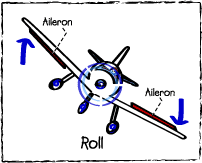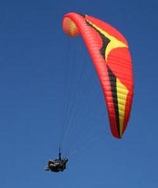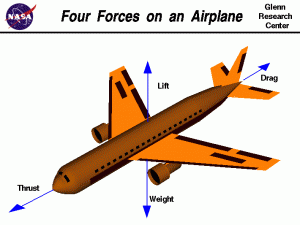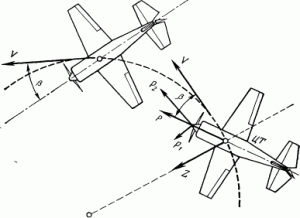Everyone, who flies reasonably often has a chance to observe a remarkable effect: no matter how steep the roll angle of an airliner is during a turn, the tea in your cup will always stay parallel to the floor, and not to the ground. In the course of one recent unexpectedly long discussion on this topic, it turned out there is no much easily googleable material out there to refer to. I thought I'd create some, hence a somewhat longer post on an otherwise simple matter of minor relevance to my main affairs.
So, firstly, why doesn't tea orient itself parallel to the ground? To understand that, consider a pair of insightful examples. They should rid you of the incorrect intuitive assumption that it is gravity, which plays a defining role in the orientation of your tea.
Example 1: Water in the bucket
Consider the experiment described in the previous post about a water bucket on a string. No matter what you do with the bucket, as long as the string is at strain, the water will stay parallel to bottom of the bucket, and not to the ground. The explanation for that is the following. Water is affected by gravity G. The bucket is affected by gravity G and the strain of the string S. Therefore, from the frame of reference of the bucket, water experiences force G-(G+S) = -S, which pulls it towards the bottom of the bucket.
Example 2: Paragliders
You have probably seen paragliders in the air. If not, just search for "extreme paragliding" on youtube. Note that whatever the angle of the wing, the person is always hanging perpendicularly to it. Now if you'd hand him a bottle with water, the water would, naturally, also orient itself in parallel to the wing. The reason of that behaviour is the same as in the water bucket experiment, with the lift of the wing playing the same role as the strain of the string.
The main idea of both examples is that as long as the container and the object inside it are equally affected by gravity, it is not gravity that orients the object with respect to the container. More precisely, for the water to incline to the side, there must be some force acting on the container from that side.
The Airplane: A Simple Model
Let us now consider an idealized airplane. According to a popular model, an airplane in flight is affected by four forces: the thrust of the engines T, the drag due to air resistance D, the lift of the wings L and the gravitational weight of the airplane G. The glass of tea inside the airplane is, of course, only affected by gravity G. By applying the same logic as before, we can easily compute, that in the frame of reference of the airplane, the tea is experiencing acceleration F = G-(T+D+L+G) = -(T+D+L).
However, once the airplane has attained constant speed (which is true for most of the duration of the flight), its thrust is completely cancelled by the air resistance, i.e. T+D = 0, in which case F = -L. It now remains to note that the lift force of the wings is always approximately perpendicular to the wings and thus to the floor of the airliner. The tea in your cup must therefore indeed be parallel to the floor.
The Airplane: A More Realistic Model
The model considered in the previous section is somewhat too simplistic. According to it there are no forces acting on the sides of the airplane whatsoever, and it should therefore be absolutely impossible to incline the tea in the cup to the side, which is, of course, not true for a real airplane. So, assuming a pilot would want to incline the tea and spill it, what would be his options?
- Thrust. As noted above, tea must only be parallel to the floor when thrust is perfectly cancelled by drag and the plane is moving with constant speed. A rapid increase or decrease in thrust could therefore incline the tea towards or against the direction of flight. But of course, there is usually no need for such a maneuver during a passenger flight except for takeoff and landing.
- Rotation. The model above does not consider the fact, that the pilot may use the ailerons and rudder to turn the airplane, rotating it around its axes. And of course, when the resulting rotation is abrupt enough, the tea could incline somewhat. However, during passenger flights the turns are always performed very smoothly, with rotation speeds around 1 degree per second. In fact it is risky, if not impossible to perform any hasty rotationary maneuvers on an airliner travelling at about 800km/h.
-
Slip. The simple model above considered the case when the air is flowing directly along the main axis of the airplane, which need not necessarily always be the case. The condition may be violated either due to a strong sidewind, or during a peculiar kind of a turn, where the airplane "slips" or "skids" on the side. In both cases, the airflow is exerting pressure on the side of the airplane's hull, which generates the so-called body lift. It is usually incomparably smaller than the lift of the wings, but nonetheless, it can incline the water to the side.
It is interesting to understand why you should almost never experience slip in an airliner. There are two reasons for that. Firstly, most airplanes have a degree of weathercock stability. Like a weathercock, an airplane with a vertical tail stabilizer tends to automatically orient itself into the direction of airflow and thus avoid slip. This effect is especially strong at the speed of a commercial airliner.
Secondly, if the weathercock effect is not enough to prevent slip, the pilot himself will always ensure that the slip is never too large by watching the slip-indicator (aka inclinometer) and coordinating the turn.
Why that? Because the airplane is not constructed, aerodynamically, to fly sideways. When the plane is moving sideways, the body of the plane blocks airflow over the trailing wing. So the wing loses lift and begins to drop. This naturally will put the airplane into a bank in the direction of the turn, but it does so at great cost in drag. When the slip is too large the lifting properties of the wings change so drastically that this might put the airplane at the risk of a crash.
Summary
Q: Why is the tea in an airliner parallel to the floor even when the airplane is turning?
A: It follows from the following three conditions, that must all be satisfied for a safe flight:
- The forces of thrust and drag cancel each other and the airplane moves at a constant speed.
- The turns are performed smoothly.
- There is no slip: the air flows directly along the main axis of the airplane.










